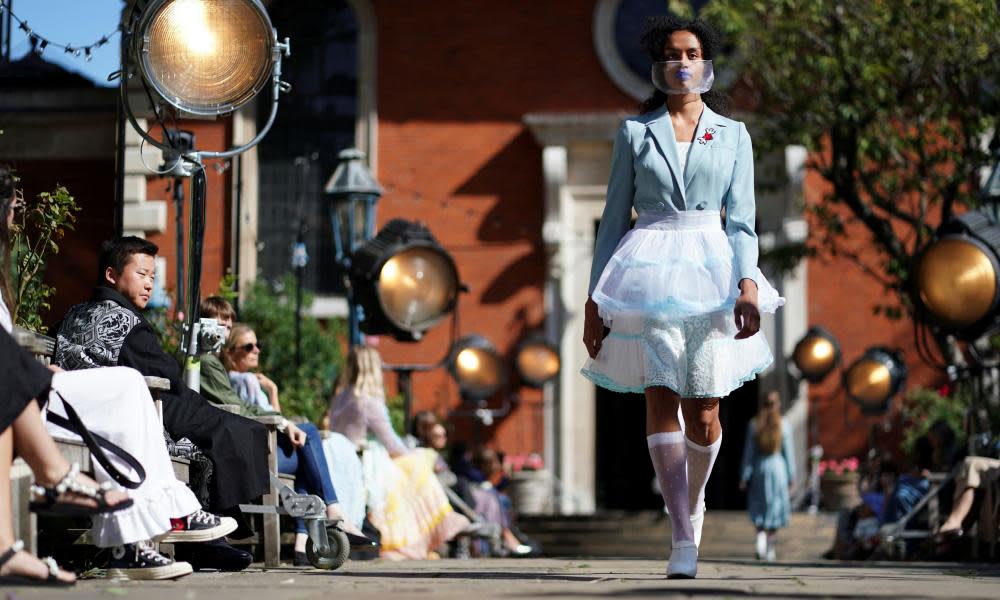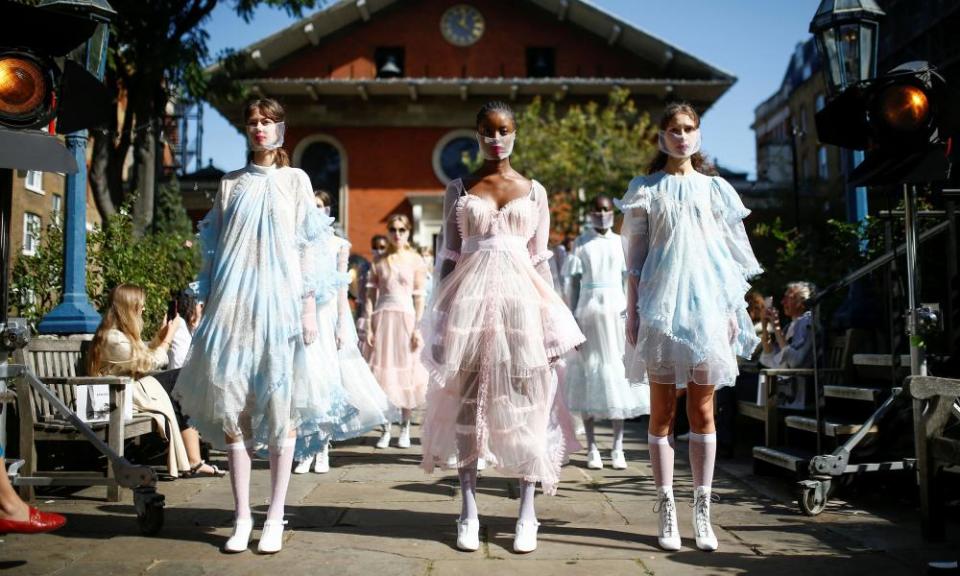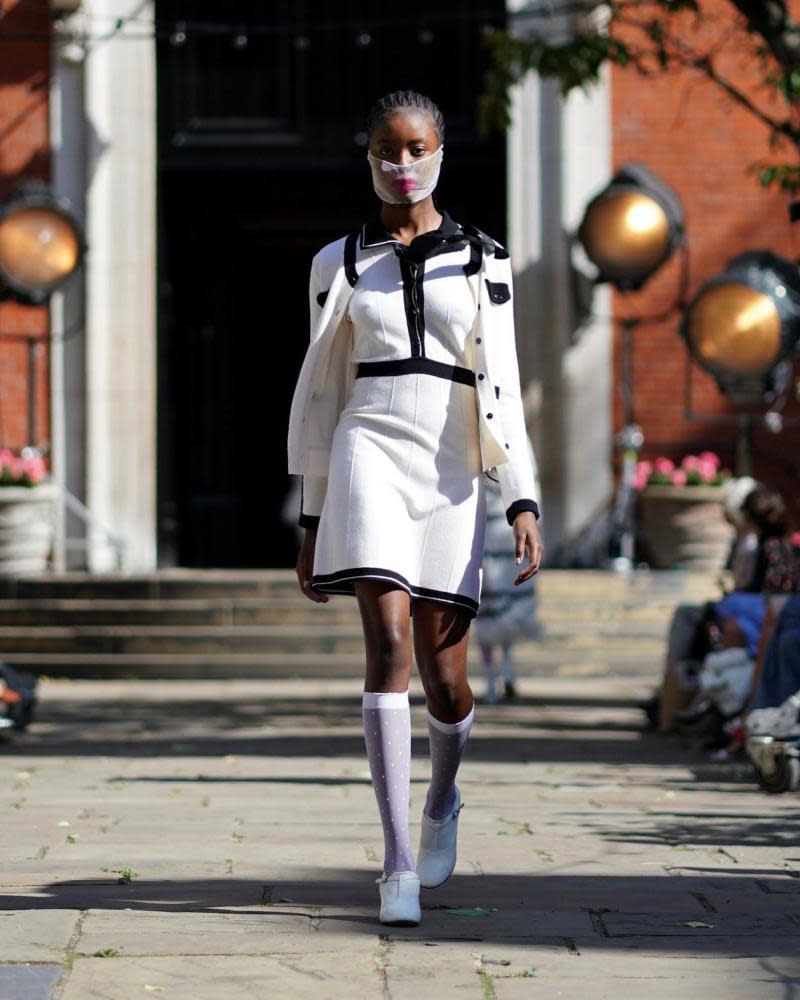'This moment needs joy and optimism and feathers' – London fashion week aims to stay upbeat

London’s first catwalk show since lockdown opened with traditional nurse’s whites, complete with starched collars and nostalgic ruffle-edged aprons – although this was fashion week, so face masks were sheer organza and worn with pillar box red lipstick beneath.
The designer, Bora Aksu, had been thinking about the nurses of 1918, who faced dealing with the flu pandemic immediately after a war. Aksu followed the starched whites with a flurry of party dresses in the frosted pastels of 1920s flapper dresses, because, he says, “we need to remember that things will get better after this, as they did then”.
In a sunny Covent Garden churchyard, Aksu’s 20-strong audience is socially distanced via the allocation of a wooden bench each. A few show-goers accessorise their face masks by layering coordinated veils in fishnet or lace over the top, in the style of Marlene Dietrich’s veiled hats. Aksu, who has shown at London fashion week for 14 years, is one of only three designers following through with a live fashion show to an audience this season. Those designers who had planned indoor shows, even on a tiny scale, have in the past few days mostly switched to individual appointments due to anxiety about rising infection rates.

Arianna, a senior staff nurse at Homerton hospital, has a starring role at this London fashion week bedecked in pink-and-gold leopard jacquard. Instead of casting models for a catwalk show, the designer Michael Halpern photographed his new collection on frontline workers. Latifah, a tube driver, wears a bubble-shaped feathered dress, and healthcare assistant Chevonese a cocktail suit in French tweed. “I think this moment needs joy and optimism and feathers and levity,” says Halpern, a disco-obsessed Versace alumna. He has loungewear covered, too – a silk pyjama suit in orange zebra stripes, with gold buttons.
“It feels almost an act of defiance or resistance, to keep making beautiful things in such an ugly time,” says the designer Erdem Moralioglu, who usually hosts a celebrity-packed show in the National Portrait Gallery but this season dressed models for a walk through Epping Forest, filming them for a video he is showing on his iPad Pro at one-on-one appointments in the basement of his boutique. “I don’t think this moment is all about casualwear,” he says, in front of a rail heaving with dresses with puff sleeves lined in tulle, and cashmere knits with red velvet bows and diamante buttons. “I believe it’s about clothes which you really love and will keep for ever.”
Fashion badly needs optimism. Business is “challenging”, says Erdem; Preen’s co-designer Justin Thornton says it is “tough. We haven’t had any income since March.” In April, Debenhams went into administration owing Thornton and his partner, Thea Bregazzi, substantial unpaid fees for their long-running diffusion line. A lockdown craft project with their children, making jewellery from broken pieces of crockery, evolved into a collection made entirely from unused remnants of fabric. Scraps of willow-pattern blue-and-white floral silk are spliced with shards of lace to make a barely there slip dress that has maximum appeal – and minimal environmental impact.

“The world was falling to pieces while we were making this collection, so we were thinking – can we put pieces back together and make something beautiful?” explains Thornton. Buyers who have seen the collection are enthusiastic, but he expects orders to be conservative in size.
“Does it feel like fashion week? Well, I’ve had a blow-dry, which was the first time I’d been to the hairdresser in six months,” says Alice Temperley, who is spending fashion week taking meetings in the showroom above her Mayfair store.
Temperley has rebalanced her offer to focus more on loungewear. “Nobody is getting married or having parties, but slip dresses and kimono are doing well.” Her spring collection is softly glamorous, with two-piece knit looks and trailing 60s kaftans. “It’s escapist, but then we are always escapist,” she says. “That’s what I do.”
Not everyone in fashion embraces the escapist route. Bethany Williams, who was one of three young designers who created the Emergency Designer Network to coordinate PPE production during lockdown, designed her latest collection to be shown as an exhibition at Somerset House. Williams volunteers and fundraises for the Magpie Project, a charity in Newham, east London, supporting mothers and children in temporary accommodation; drawing workshops she ran there over lockdown were the starting point for new season prints. Williams has delayed the opening date of the exhibition, “because it doesn’t feel right to do it until I can have the Magpie mums there with me”.
She has recently been awarded government funding to produce a reusable surgical gown, an attempt to address the problem of disposables in the pandemic.
“I miss the adrenaline of a show,” says the Australian designer Nicky Zimmermann, who is missing fashion month while grounded in Sydney. “That last couple of minutes backstage, when you’re terrified a hat is going to fall off – I miss that.”


